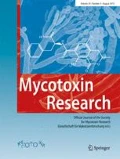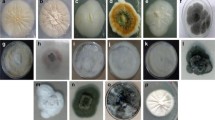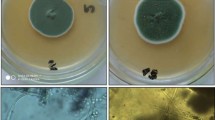Abstract
The secondary metabolite profiles of microfungi of the genus Penicillium isolated from samples of grape berries collected in two different phases during two vegetative seasons in Slovakia is described to assess the taxonomy. Three Slovak vine regions have been selected for this study, based on their climatic differences and national economic importance. Cultures of microfungi isolated from berries were incubated on different selective media for macro and micromorphology identification. The species Penicillium brevicompactum, Penicillium crustosum, Penicillium chrysogenum, Penicillium expansum, Penicillium palitans and Penicillium polonicum were identified according to growth and morphology. The related strains were found to produce a broad spectrum of fungal metabolites, including roquefortine C, chaetoglobosin A, penitrem A, cyclopeptin, cyclopenin, viridicatin, methylviridicatin, verrucofortine, secalonic acid D, cyclopiazonic acid, fumigaclavine and mycophenolic acid. Chemotaxonomy was performed using high-performance liquid chromatography (HPLC) and mass spectrometry (MS). Dried grape berries were also analyzed allowing to assess the presence of patulin, roquefortine C and penicillic acid; this last one has been identified in dried berries but not in vitro.
Similar content being viewed by others
References
Abrunhosa L, Paterson RRM, Kozakiewicz Z, Lima N, Venâncio A (2001) Mycotoxin production from fungi isolated from grapes. Lett Appl Microbiol 32:240–242
Adrio JE, Demain AL (2003) Fungal biotechnology. Int Microbiol 6:191–199
Andersen B, Smedsgaard J, Frisvad JC (2004) Penicillium expansum: consistent production of patulin, chaetogalobosin, and other secondary metabolites in culture and its natural occurrence in fruit products. J Agric Food Chem 52:2421–2428
Bentley R (2000) Mycophenolic acid: a one hundred year odyssey from antibiotic to immunosuppressant. Chem Rev 100:3801–3825
Cole RJ, Dorner JW, Cox RH (1983) Two classes of alkaloid mycotoxins produced by Penicillium crustosum Thom isolates from contaminated beer. J Agric Food Chem 31:655–657
El-Banna AA, Pitt JI, Leistner L (1987) Production of mycotoxins by Penicillium species. Syst Appl Microbiol 10:42–46
Frisvad JC, Filtenborg O (1983) Classification of terverticillate Penicillia based on profiles of mycotoxins and other secondary metabolites. Appl Environ Microbiol 6:1301–1310
Frisvad JC, Filtenborg O (1989) Terverticillate Penicillia: chemotaxonomy and mycotoxin production. Mycologia 81:836–861
Frisvad JC, Andersen B, Thrane U (2008) The use of secondary metabolite profiling in chemotaxonomy of filamentous fungi. Mycol Res 112:231–240
Gareis M, Gareis EM (2007) Guttation droplets of Penicillium nordicum and Penicillium verrucosum contain high concentrations of the mycotoxins ochratoxin A and B. Mycopathologia 163:207–214
Labuda R, Tančinová D (2003) Potentially toxinogenic species of the genus Penicillium LINK in poultry mixed feeds. Biologia 58:1043–1051
Mikušová P, Ritieni A, Santini A, Juhasová G, Šrobárová A (2010) Contamination by moulds of grape berries in Slovakia. In Food Additives and Contaminants: Part A: Chemistry Analysis Control Exposure & Risk Assessment 27: 738–747
Overy DP, Frisvad JC (2005) Mycotoxin production and postharvest storage rot of ginger (Zingiber officinale) by Penicillium brevicompactum. J Food Prot 68:607–609
Pitt JI, Hocking AD (2009) Fungi and food spoilage, vol Chapter 7, 3 rdth edn. Springer Science - Business Media, Berlin, Germany
Reddy CS, Reddy RV (1991) Secalonic acids. In: Sharma RP, Salunkhe K (eds) Mycotoxins and phytoalexins. CRC Press, Boca Raton, Florida, USA, pp 167–190
Rundberget T, Wilkins A (2002) Determination of Penicillium mycotoxins in foods and feeds using liquid chromatography mass spectrometry. J Chromatogr 964:189–197
Samson RA, Frisvad JC (2004) Penicillium subgenus Penicillium: new taxonomic schemes and mycotoxins and other extrolites. Stud Mycol 49:1–251
Scott PM, Fuleki T, Harwig J (1977) Patulin content of juice and wine produced from moldy grapes. J Agric Food Chem 25:434–437
Serra R, Braga A, Venâncio A (2005) Mycotoxin-producing and other fungi isolated from grapes for wine production, with particular emphasis on ochratoxin A. Res Microbiol 156:515–521
Smedsgaard J (1997) Micro-scale extraction procedure for standardized screening of fungal metabolite production in cultures. J Chromatogr A 760:264–270
Stoev SD, Denev S, Dutton MF, Njobeh PB, Mosonik JS, Steenkamp PA, Petkov I (2010a) Complex etiology and pathology of mycotoxic nephropathy in South African pigs. Mycotoxin Res 10:31–46
Stoev SD, Dutton MF, Njobeh PB, Mosonik JS, Steenkamp PA (2010b) Mycotoxic nephropathy in Bulgarian pigs and chickens: complex aetiology and similarity to Balkan Endemic Nephropathy. Food Addit Contam A 27:72–88
Vinokurova NG, Reshetilova TA, Kozlovsky AG (1992) Biosynthesis of alkaloids in Penicillium palitans under various growth conditions. Prikladnaya Biokhimiya i Mikrobiologiya 28:875–879
Vishwanath V, Sulyok M, Labuda R, Bicker W, Krska R (2009) Simultaneous determination of 186 fungal and bacterial metabolites in indoor matrices by liquid chromatography/tandem mass spectrometry. Anal Bioanal Chem 395:1355–1372
Acknowledgments
The work was supported by Project VEGA No. 2/0190/13 and MycoRed.
Conflict of interest
None
Author information
Authors and Affiliations
Corresponding author
Rights and permissions
About this article
Cite this article
Santini, A., Mikušová, P., Sulyok, M. et al. Penicillium strains isolated from Slovak grape berries taxonomy assessment by secondary metabolite profile. Mycotoxin Res 30, 213–220 (2014). https://doi.org/10.1007/s12550-014-0205-3
Received:
Revised:
Accepted:
Published:
Issue Date:
DOI: https://doi.org/10.1007/s12550-014-0205-3




